PARISH OF ST. PATRICK'S, CLONALLON
MAYOBRIDGE
by Gerry Quinn
"GREETINGS AND BLESSINGS to our Beloved Brother Priest, the
Very Rev. Thomas McConville. As a new Parish has been erected to be
known as St. Patrick's Clonallon, and since according to the norm of
Canon 521, it is clear to us that you have the required qualities of
good morals, sound doctoring, zeal for souls, prudence and the other
virtues necessary for the wise direction of this Parish, we hereby
appoint you Parish Priest of St. Patrick's, Clonallon according to
Canon Law and we enjoin on you the zealous care of souls to be
exercised under the authority of the local Ordinary.
As proof of this, we have ordered this letter
of ours, stamped with the Episcopal seal, to be handed over. Given
at the Bishop's House, Newry, on this the twenty-sixth day of
January in the year of Our Lord one thousand nine hundred and eighty
four"
FRANCIS
GERARD BROOKS
Bishop of Dromore
With these words, Father Tom McConville became the
last in a long line of much-loved curates of the Mayobridge section of
Clonallon Parish and immediately became first Parish Priest of the new
parish of St. Patrick's, Clonallon, known locally as Mayobridge Parish.
Mayobridge or 'Droichead Mhaigh Eo', commonly known
as 'the Bridge' and taking its name from the structure spanning the
first stretch of the Clanrye River and separating the townlands of Mayo
and Bavan, became a parish in its own right on 26th. January 1984. It
had formerly been part of the Parish of Clonallon.
Aughnagun - Achadh na ngambain: the field
of the calves, or Ath na ghun: forest of the hounds.
Ballydulaney - Baile Dubh lainne: the dark
townland of the road or pass.
Ballyvalley - Baile an bhealaigh: townland
of the road or pass.
Bavan - Badhun: a cattle enclosure.
Cabragh - Cabrach: bad land, poor quality,
mountain grazing very infertile.
Carnmeen - Ceathranhadh Mhin: the level
quarter. The old townlands or `Ballybetaghs' were often divided into
quarters, each of which was usually designated by the word `Ceathramhadh'
or `Ceathru'. The four quarters into which the townland was divided were
generally distinguished by their size, shape and the quality of the
land. The measure of the level quarter was that understood by native
speakers in the district in the mid-I800s.
Part of Carnaney - Ceathramhadh Eanaigh:
the marshy quarter.
Carrickcrossan - Carraig Mhic an Chrossain:
O'Crossan's rock or the rocky land of Crossan or Crosbie. Another
interpretation for this townland name is the rock of the little crosses.
The former appears more authentic however since the land therein is a
mass of rocks and boulders with very little arable content.
Croan - Cruadhan: very hard ground, of
poor quality and of little use for farmers.
Cullion - Bode an Churilinn/Cuileann: The
townland of the holly tree. It probably had `baffle' as a prefix.
Edentrumley - Eadan Tromlaigh: the
hill-brow of the elder or boor tree.
Mayo - Maigh Eo: the plain of the Yew
trees.
Part of Tamnaharry - Tainhnach na Cairthe:
the green field of the pillar stone - the pillar stone being located in
the valley behind Tamnaharry Mountain.

ST. PATRICK'S CHURCH,
MAYOBRIDGE.
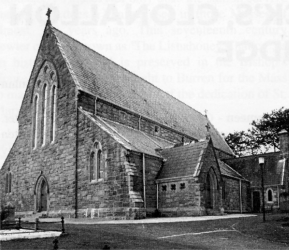
St. Patrick's Church is an
imposing landmark in the surrounding countryside.
The church is in use since 1862,
St. Patrick's Church, Mayobridge, was, according to
the historian, Hugh Digenan, erected on the site of a former Mass Rock
and replaced an earlier church, which had been erected in 1806, part of
which is now the disused Mayobridge Parochial Hall. The present church
was erected by Fr. Brennan, who, it is related, was wont to remind the
people to say a prayer for him every time they saw that edifice, for
often he had "blistered his feet travelling through England" in order to
raise the money to build it.
A fine Gothic-style building and reputed to be the
largest `country' church in the diocese, it can hold up to 600
worshippers in comfort. From the front entrance, it commands a fine view
of the surrounding countryside right into County Armagh and beyond.
Dr. Leahy, co-adjutor bishop of the diocese, blessed
the foundation stone of St. Patrick's Church on 15th. August 1859 and a
little over three years later, on I2th. October 1862, the same pious
prelate officiated at the dedication ceremony. The preacher of the
dedicatory sermon was the Bishop of Kerry, Dr. David Moriarty. As a
result of his powerful appeal the congregation subscribed over �500
towards the new Church.
The erection of St. Patrick's Church witnessed the
growth of the village of Mayobridge. which derives its name from a
structure, by no means notable, spanning the river separating Mayo and
Bavan townlands. In the middle of the last century the region was known
far and near as "The Bridge of Mayo," and in the surrounding countryside
it is still referred to as "The Bridge of Mayo." Associated with the
rise of Mayobridge was the O'Hare family, who originally came from
Ballydoo. An avenue of trees through the village planted by the late Mr.
John O'Hare and his brother, the late Peter O'Hare, recalls memories of
their many public activities. A member of this family, Canon Frank
O'Hare, later became Parish Priest of Seapatrick.

DR. ANTHONY GARVEY
BISHOP OF DROMORE, 1747-66
Born in Aughnagun, he was a member of a noted family
who owned the townland of Aughnagun and was the youngest son of Dudley
and Brigid Garvey. As priest and bishop, he appears to have resided
mostly at the family homestead. Fr. Garvey was educated at Paris, where
he took L.L.D degree. In 1726, he was P.P. of his native parish and
Vicar General of the diocese. His period as Bishop marked important
changes in diocesan administration, despite the penal code which
presumed no such person as a bishop to be living in Ireland. In time,
however, Catholics began to enjoy some small measure of religious
freedom with relaxations in the penal code. During his reign, a few
churches and a number of Mass Houses were openly erected in the diocese.
He was responsible for the constitution of Newry and Clonallon as mensal
parishes and from this time onwards, Newry, instead of Dromore, became
the seat of diocesan authority. Before his death, he erected a family
vault in St. Mary's Cemetery, Newry. He died at his residence in
Aughnagun on 24th. August 1766. His Will is a document of human
interest, throwing some light on his relationship with his immediate
friends and relatives. The original Will, unfortunately, was destroyed
in the Public Record Office, Dublin, during a bombardment in the Irish
Civil War in 1922.
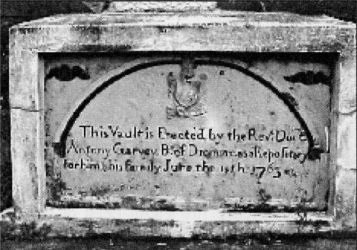
The remains of Bishop Garvey and
several members of his family rest in this vault at
St. Mary's Cemetery, Newry.
THE POOR CLARE SISTERS IN
MAYOBRIDGE
St. Clare's Convent was founded in 1924 due to the
inspirational benevolence of Elizabeth Barry. She donated her house and
property to Most Reverend Dr. Mulhern, Bishop of Dromore, with the
express wish that a convent be established there. Her generosity has had
a profoundly beneficial effect upon the spiritual and educational
welfare of all the people in the district. The decision to found the
Convent in Mayobridge was taken on the 3rd. October 1922 and the
building of the new convent proceeded very shortly after that. The
foundation stone was laid and blessed on the 3rd. May 1923 by Most
Reverend Dr. Mulhern. By January 1924, the following Sisters were chosen
for the foundation: Mother Mary Anthony Clune, Mother-in-Charge. Mothers
Mary Josephine
O'Hare, Mary Dominic Ryan, Mary Elizabeth Carr and
Mary Gabriel Breen. They were installed on the 25th. February 1924. The
rules of the Order were relaxed allowing the Sisters to attend Mass
publicly and to teach. They were also allocated duties as sacristan to
the church; Mother Mary Josephine and Mother Mary Bonaventure were
appointed assistant teachers in the boys' school. Due to legal
technicalities, building work on a proposed new school was delayed and,
with the existing school being considered unsafe, a temporary classroom,
later called the Sodality Room, was built. It, along with two rooms in
the Convent, were used to accommodate the pupils pending the completion
of the new school.
The new schools were opened on the 20th. May 1927.
Mother Mary Evangelista was appointed assistant teacher on the 1st.
February 1926 to replace Mother Mary Bonaventure, who was transferred to
Newry as Novice Mistress.
Space does not allow for adequate expression of the
debt of gratitude owed by the people of Mayobridge to this Community of
Sisters of St. Clare. The present Mother Superior is Mother Attracta
Devlin.
There are over 1,800 Poor Clare nuns throughout the
world. A new mission has recently been opened in Guatemala and there are
over thirty postulants. We hope that we can continue to enjoy the
presence of the Poor Clares among us in the decades to come

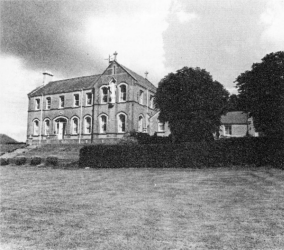
The Sisters of St. Clare have
maintained a much-valued presence in Mayobridge for
eighty years. Their Convent (above), was established in
1924.
The first written record of school in the Mayobridge
area is from the 1824 Report on Education, which mentions a
`Hedge School' in Aughnagun; Teacher: Charles Carr, salary about �5.
School: a cabin of the worst description, costing �3. The Catholic
return was 21 Catholics and 3 Protestants, 16 boys and 8 girls. The
Protestant return was 18 Catholics and 4 Protestants, 12 boys and 10
girls. Both versions of the Bible were read.
Also in Aughnagun was another school; Teacher:
Terence McAleavey, salary �2.10.0, with house and 31/2 acres of land
rent free. School: a cabin (poor), costing �4.0.0. Both Catholic and
Protestant returns record 16 Catholics on the rolls, 10 boys and 6
girls. Authorised Version of the Scriptures were read. Roger Hall, of
Narrow Water, had given land rent-free and tithe free.
In Croan, the teacher was Hugh Grant; his salary was
�16. The school was "a badly-thatched cabin," costing about �3. Both
Catholic and Protestant returns record 41 Catholics, 10 Presbyterians
and 2 others on rolls, 36 boys and 17 girls.
In Mayo, the teacher was Edward Grant; his salary was
�12. The school was a "wretched cabin," costing about �3.0.0. Catholic
and Protestant return 37 Catholics 32 boys and 5 girls. No Bible was
read.
The Ordnance Survey Memoirs mention that, in
1834, there was in the townland . of Ballydulaney: "One small school,
average 40 scholars," with a footnote: "The inhabitants would be very
willing to send their children if they could get any encouragement from
the government."
The Ordnance Survey Memoirs of 1835 state that
a National School was situated near Mayo Chapel (now the Parochial
Hall). It was a small slated cottage established by the National Board
of Education in November 1832. The income from the National Board was
�10 per annum and one shilling per pupil. The books used were those
furnished by The National Board and the moral education was such as
allowed by the Board.

In September I836, the attendance at Mayo School was
103 boys and 48 girls, the Master was Owen Fegan.
As far as is known, that building later became the
band room for the Sacred Heart Flute Band and, later still, it became a
dance hall and then a dinner hall. Although these schools are the first
we have written evidence about, there must have been other schools in
the area long before that.
Dr. Anthony Garvey was a graduate from the University of
Paris, so we may assume he got the foundation of his education at a
hedge school.
According to the Report on the State of Popery in
Dromore Diocese, submitted to the House of Lords in November 1731,
"The papists of this county were of the lowest rank, yet papists they
still are, under the unbounded guidance of their Priests who have their
private and public meetings as they think proper." Dean Pulleine, who
came from this area, wrote a catechism in Irish in the early 1700s and
The Imitation of Christ was translated from Latin to Irish in
Drumnaquoile about 1762. It is likely therefore that the Greek and Latin
classics, and possibly continental languages, were being taught in
humble cabins all round the country a hundred and more years before
schools were officially known.
From 1832, up until the present school was built, the band room and,
after I862, the present parochial hall served as locations for Mayo
National Schools. The condition of the band room especially, gave cause
for concern. An Inspection Report of 24th. April I91I, after commenting
on how the Girls' School was run, stated "A new school house is badly
needed". In the early 1920s, Masters O'Hagan and McGlinchey had classes
in the band room. Pierce Fegan and later Sr. Mary Bonaventure taught in
the Parochial Hall. In 1912, the Inspectors' report commented, regarding
the Girls' School, "Work is carried out in this school under
unfavourable conditions, as the house is very old and hardly
suitable.... The tone is fairly good and on the whole, the pupils are
making fair progress. Needlework shows some improvement.... Equipment
for manual instruction still inadequate."
The 1914 report stated something similar.
In 1923 there were 120 children attending the schools
in Mayobridge and there were plenty of complaints regarding the state of
the buildings. In September of that year Canon McGinnis wrote to Newry
No. 1 Rural District Council stating that the schools were far from
satisfactory and that he hoped to get work started soon on building a
new school.
The new school was built, and officially opened on
20th. May 1927. It took, therefore, nearly four years from inception
until completion. The plans were prepared by R.A. Smyth, Belfast, and
the contractors were M/s Harding & Harding, Belfast. M/s Salmon & Cooke,
assistant architects, supervised the construction work and P. McGivern,
Warrenpoint, was Clerk of Works.
The Frontier Sentinel stated that the new
building gave utmost satisfaction to Canon McAlister, (who had succeeded
Canon McGinnis), the local curate Dr. O'Hare, the Poor Clare nuns, and
Mr. P.D. McEvoy and Miss Marianne Flynn - the principals of the boys'
and girls' schools. The Bishop, Dr. Mulhern, and several visiting clergy
processed from St. Patrick's Church to the schools, with the
schoolchildren singing hymns along the route.
The school remained unchanged until the late 1940s
when a new toilet block was built outside. In 1960, two new classrooms
were built. In 1984, the school was further enlarged and now comprises
ten classrooms, two resource areas, an assembly/dininghall, two offices,
a library, a play room and a large staff room, together with an
extensive school meals' kitchen. There are three playgrounds and a
playing field.
Mayobridge has always been fortunate in the quality
of the teaching staff attracted to the school. Names like Masters Fegan,
Master McGlinchey, Master O'Hagan, Miss Flynn, Master McEvoy, Mother
Josephine, Mother Philomena, Mother Evangalista spring to mind.

The boys' and girls' schools were amalgamated about
1960.
The first roll comprised 151 pupils. A century later,
the number remained 150 approximately. Now, 280 pupils are in
attendance. The Scheme of Education in the early part of the century
placed great emphasis on Reading, Composition, History, Geography and
Arithmetic. For girls. Needlework was an essential part of the school
curriculum. In 1920, the inspection report commented that the children
had a good knowledge of a play by Shakespeare. Miss Hogan taught
Cookery, Laundry and Needlework. Master McEvoy introduced us to Algebra
at school. He talked about foreign countries, describing life in Canada,
the United States and Africa in his own unique way. We looked forward to
the singing lessons when he brought down the fiddle and we sang `An
English Country Garden.'
Over the years the school has developed to keep up
with changing times. There is now a teaching staff of twelve. There are
three classroom assistants and eighteen additional staff. The present
curriculum includes English, Maths, Science and Technology, Religious
Education, Environmental studies, Speech and Drama, Computer Education,
Arts and Crafts, Music and P.E.
Education in this small community has grown by leaps
and bounds from its humble beginnings in Aughnagun, Ballydulaney, Croan
and Mayo - where children and teachers huddled round a cold, dark
thatched cabin - to the magnificent school we have today.
A curate of Clonallon Parish had lived in the
Mayobridge area since 1859. This was the year when work began on
building the present St. Patrick's Church. The curates originally lived
in accommodation located on the main Newry to Hilltown Road. A new
presbytery was, in due course, erected on a site opposite the church.
This property was completed in 1885 and was first occupied by Fr. Edward
MacCartan C.C. The need for a replacement of it was addressed shortly
after the erection of the new Mayobridge Parish. A new bungalow was
contructed soon afterwards and Fr. Tom McConville became its first
occupant, in July 1985.
Fr. McConville continued as Parish Priest until the
summer of 2000. He retired, at that point, after eighteen years of
dedicated service to the Mayobridge people. The highly respected pastor
has continued to serve, in his retirement, in the neighbouring parish of
Drumgath. Fr. John Joseph Cunningham succeeded as Parish Priest in July
2000. Fr. Cunningham, a native of Kilcoo, was ordained in 1972. He
served on the staff of St. Colman's College in the years following his
Ordination and later spent several years as a popular curate in
Warrenpoint and in Drumaness. Fr. Cunningham has led, since coming to
Mayobridge, a refurbishment of the sanctuary and interior of St.
Patrick's Church. The project was undertaken, following a fire, between
March and June 2003.

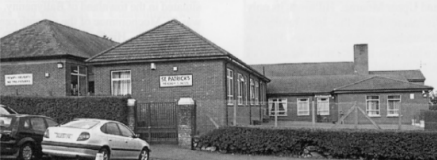
Mayobridge has a proud record in
Catholic Primary Education. St. Patrick's Primary School
continues to thrive, at the heart of the parish.
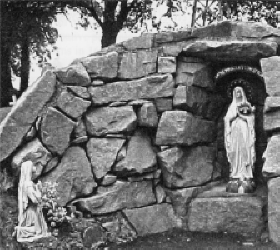
This grotto, in honour of Our Lady of
Lourdes, was constructed by the parishioners of
Mayobridge to commemorate the Marian Year, 1987.
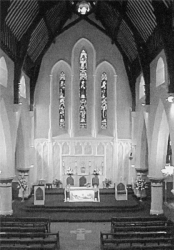
The striking interior of Mayobridge
Church. The sanctuary was renovated in 2003, The altar
tableau originally belonged to St. Mary's Church, Burren
and was brought to Mayobridge c.1940.
 |